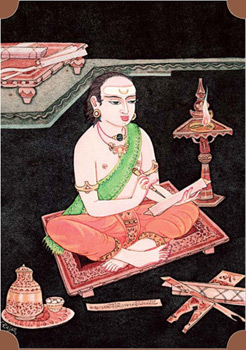
 What Is the Nature of the Veda Texts?
What Is the Nature of the Veda Texts?
The holy Vedas, man’s oldest scripture, dating back 6,000 to 8,000 years, are a collection of four books: the Rig, Sama, Yajur and Atharva. Each has four sections: hymns, rites, interpretation and philosophical instruction. Aum.§
Using the traditional elutani, stylus, a pandit scribes memorized Vedic verses on dried palm leaves. For centuries the Vedas were passed on orally, then finally transcribed. Left, a devotee leafs through his holy text as he performs his morning sadhana. §
 HE OLDEST AND CORE PORTIONS OF THE VEDAS are the four Samhitas, “hymn collections.” They consist of invocations to the One Divine and the Divinities of nature—such as the Sun, the Rain, the Wind, the Fire and the Dawn—as well as prayers for matrimony, progeny, prosperity, concord, domestic rites, formulas for magic, and more. They are composed in beautiful metrical verses, generally of three or four lines. The heart of the entire Veda is the 10,552-verse Rig Samhita. The Sama and Yajur Samhitas, each with about 2,000 verses, are mainly liturgical selections from the Rig, whereas most of the Atharva Samhita’s nearly 6,000 verses of prayers, charms and rites are unique. The Sama is arranged for melodious chanting, the Yajur for cadenced intonation. Besides its Samhita, each Veda includes one or two Brahmanas, ceremonial handbooks, and Aranyakas, ritual interpretations, plus many inestimable Upanishads, metaphysical dialogs. In all there are over 100,000 Vedic verses, and some prose, in dozens of texts. The Tirumantiram confirms, “There is no dharma other than what the Vedas say. Dharma’s central core the Vedas proclaim.” Aum Namah Sivaya.§
HE OLDEST AND CORE PORTIONS OF THE VEDAS are the four Samhitas, “hymn collections.” They consist of invocations to the One Divine and the Divinities of nature—such as the Sun, the Rain, the Wind, the Fire and the Dawn—as well as prayers for matrimony, progeny, prosperity, concord, domestic rites, formulas for magic, and more. They are composed in beautiful metrical verses, generally of three or four lines. The heart of the entire Veda is the 10,552-verse Rig Samhita. The Sama and Yajur Samhitas, each with about 2,000 verses, are mainly liturgical selections from the Rig, whereas most of the Atharva Samhita’s nearly 6,000 verses of prayers, charms and rites are unique. The Sama is arranged for melodious chanting, the Yajur for cadenced intonation. Besides its Samhita, each Veda includes one or two Brahmanas, ceremonial handbooks, and Aranyakas, ritual interpretations, plus many inestimable Upanishads, metaphysical dialogs. In all there are over 100,000 Vedic verses, and some prose, in dozens of texts. The Tirumantiram confirms, “There is no dharma other than what the Vedas say. Dharma’s central core the Vedas proclaim.” Aum Namah Sivaya.§
